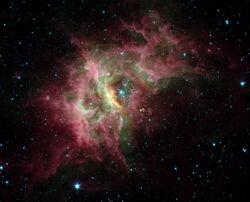Astronomy:RCW 49
| Emission nebula | |
|---|---|
| H II region | |
 | |
| Observation data: J2000.0[1] epoch | |
| Right ascension | 10h 24m 14.6s [1] |
| Declination | −57° 46′ 58″ [1] |
| Distance | 13,700 ly |
| Constellation | Carina |
| Physical characteristics | |
| Radius | 150-200 ly |
| Designations | RCW 49, GUM 29, NGC 3247 |
RCW 49, also known as NGC 3247, is a H II region[1] nebula located 13,700 light years away.[2] Other designations for the RCW 49 region include NGC 3247 and G29[3] and it is commonly known as the Whirling Dervish Nebula.[4] It is a dusty stellar nursery that contains more than 2,200 stars[2] and is about 300-400 light years across.[5] RCW 49 is recognized as among the brightest and most massive HII regions.[6]

In 2004, a 2003 image by the Spitzer Space Telescope was released showing the nebula in infrared wavelengths.[2] This included an image showing the infrared colors mapped to visible light colors: 3.6 microns (blue), 4.5 microns (green), 5.8 microns (orange) and 8 microns (red).[2] It was noted as being almost 14 thousand light years from Earth, and the infrared camera could detect the stars obscured by dust clouds.[2] It was estimated at least 200 of the stars in the nebula have dust disks.[7]
The results of observations of the Spitzer Telescope, including the IRAC camera, have been studied leading to the conclusion that the region is a star-forming region.[6] In 2014, RCW 49 was identified as a bow shock candidate, along with M17 in a study of Extended Red Objects (ERO's) and Stellar Wind Bow Shocks in the Carina nebula.[8]
See also
- RCW Catalogue
- Gum Catalog
References
- ↑ 1.0 1.1 1.2 1.3 SIMBAD, RCW 49 (accessed 4 April 2012)
- ↑ 2.0 2.1 2.2 2.3 2.4 "Star Formation in RCW 49" (in en). http://www.spitzer.caltech.edu/images/1168-ssc2004-08a1-Star-Formation-in-RCW-49.
- ↑ Lang, Kenneth R. (2012-12-06) (in en). Astrophysical Data: Planets and Stars. Springer Science & Business Media. ISBN 9781468406405. https://books.google.com/books?id=0_EHCAAAQBAJ&q=IC+2944+rcw+60&pg=PA414.
- ↑ Chadwick, Stephen; Cooper, Ian (11 December 2012). Imaging the Southern Sky. Springer. p. 77. ISBN 978-1461447498.
- ↑ "A novel type of source? Gamma rays from the vicinity of the Wolf-Rayet binary WR 20a". 2006. https://www.mpi-hd.mpg.de/hfm/HESS/pages/home/som/2006/12/.
- ↑ 6.0 6.1 Whitney, B. A.; Indebetouw, R.; Babler, B. L.; Meade, M. R.; Watson, C.; Wolff, M. J.; Wolfire, M. G.; Clemens, D. P. et al. (2004). "A GLIMPSE of Star Formation in the Giant H ii Region RCW 49" (in en). The Astrophysical Journal Supplement Series 154 (1): 315–321. doi:10.1086/422557. ISSN 0067-0049. https://iopscience.iop.org/article/10.1086/422557.
- ↑ "An "Impossibly" Young Planet?" (in en-US). 2004-06-14. https://www.skyandtelescope.com/astronomy-news/an-impossibly-young-planet/.
- ↑ Sexton, Remington O.; Povich, Matthew S.; Smith, Nathan; Babler, Brian L.; Meade, Marilyn R.; Rudolph, Alexander L. (2015-01-01). "Extended Red Objects and Stellar Wind Bow Shocks in the Carina Nebula". Monthly Notices of the Royal Astronomical Society 446 (1): 1047–1059. doi:10.1093/mnras/stu2143. ISSN 1365-2966. Bibcode: 2015MNRAS.446.1047S.
External links
- RCW 49 picture and information
- NASA Astronomy Picture of the Day: Cosmic Construction Zone RCW 49 (3 June 2004)
- Devitt, Terry (May 27, 2004). "Milky Way churning out new stars at a furious pace". http://www.news.wisc.edu/9859.
- Constellation Guide Westerlund 2 and Gum 29
 |

